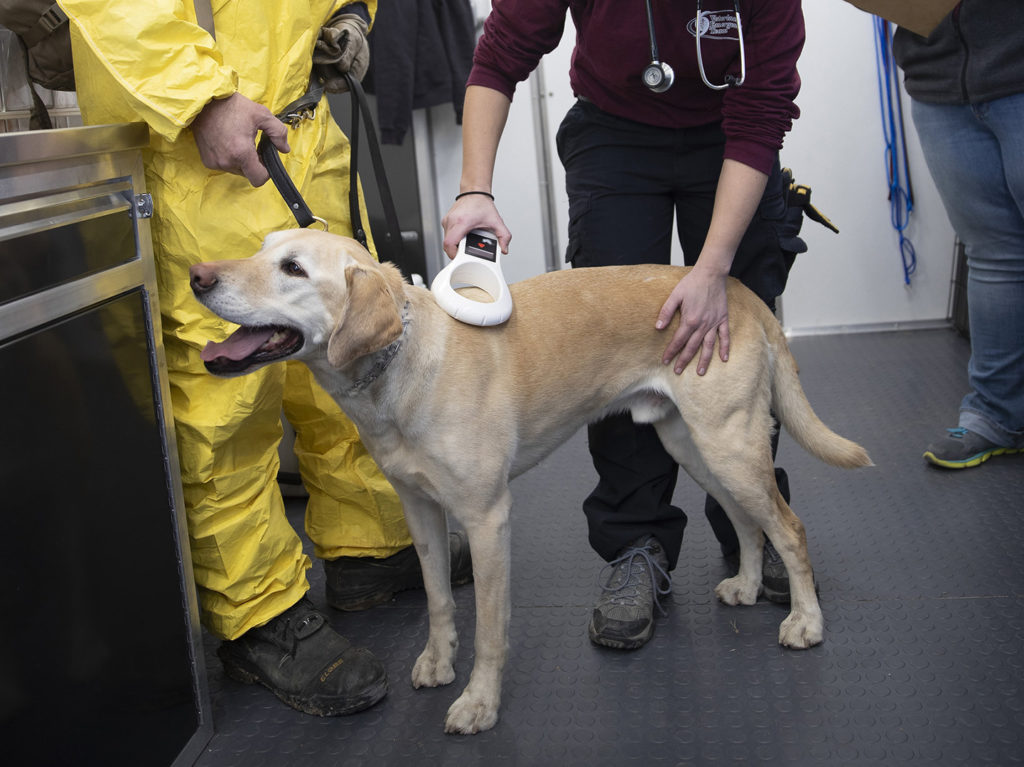Take Action Now To Prepare Pets For Evacuation

When a disaster strikes, there’s often not much time to prepare yourself, let alone your pets, to evacuate to a safe location, and the stress of the situation only compounds the likelihood of forgetting something important.
That’s why the best way to deal with a disaster is to plan ahead as much as possible.
In recognition of National Disaster Preparedness Month this September, Dr. Deb Zoran, a professor at the Texas A&M College of Veterinary Medicine & Biomedical Sciences and member of the Texas A&M Veterinary Emergency Team, shares a couple easy steps that can save pet owners a number of potential headaches during an evacuation.
The first is to create a pet disaster preparedness kit with three to seven days’ worth of food and water, two weeks’ worth of any medicines your pet needs, first aid supplies, and a copy of your pet’s medical records showing they’re up to date on vaccinations or any medical issues they have.
This kit should also include a carrier or collapsible kennel (for cats, the carrier should be large enough to have a sleeping area and litter tray); a few comfort items, such as favorite toys or a blanket, for destressing your pet; and cleaning supplies, such as waste bags and sanitizing wipes.
“The medical records are important because they may be required at an emergency shelter,” Zoran said. “It’s also a great idea each year before storm season to be sure your pet is up to date on appropriate vaccines, especially Bordetella (also known as kennel cough) for dogs and respiratory virus vaccines (FVRCP) for cats. Respiratory infections are common in highly stressed animals and especially in unvaccinated pets admitted to an emergency shelter.”
As importantly, owners should to have a way for their pet to be identified in case of separation.
“There are a number of identification methods, including collars, tattoos or other permanent markings, and microchips,” Zoran said. “Collars are less expensive but can be lost easier and are sometimes inappropriate in cats that go outdoors. Once a microchip is implanted, it is a permanent way to identify the animal.
“But, even if you have your pet microchipped or your pet is wearing a collar, it is also a great plan to have a photo of you and your animal on your phone that can be used to verify ownership,” she said.
Lastly, Zoran emphasized that owners should absolutely never leave a restrained pet alone. Whether in a vehicle, crate, tied or chained up, or in any other kind of containment, if it is unsafe for you to stay there, it’s also unsafe for your pets to stay.
Because disasters are sometimes unexpected, Zoran also reiterated the importance of having a pet evacuation plan written out ahead of time and even practicing it with your family and animals.
“In an emergency situation, it becomes really hard to remember details,” she said. “Following pre-written steps or checklists not only saves time but can help you remember little things you might forget. And practicing your plan when it’s not an emergency situation can also help you solve problems you might not have thought about.”
No matter the type of disaster, being as prepared as possible is always key to keeping your entire family, including your pets, safe.
Pet Talk is a service of the College of Veterinary Medicine & Biomedical Sciences, Texas A&M University. Stories can be viewed on the web at vetmed.tamu.edu/news/pet-talk. Suggestions for future topics may be directed to vmbs-editor@tamu.edu.


